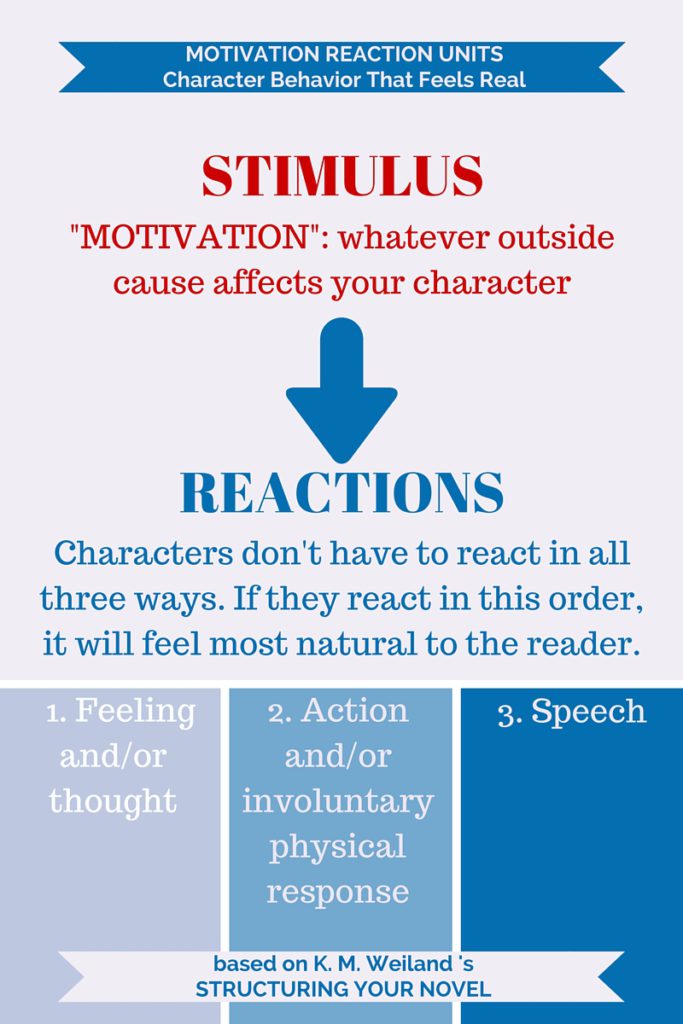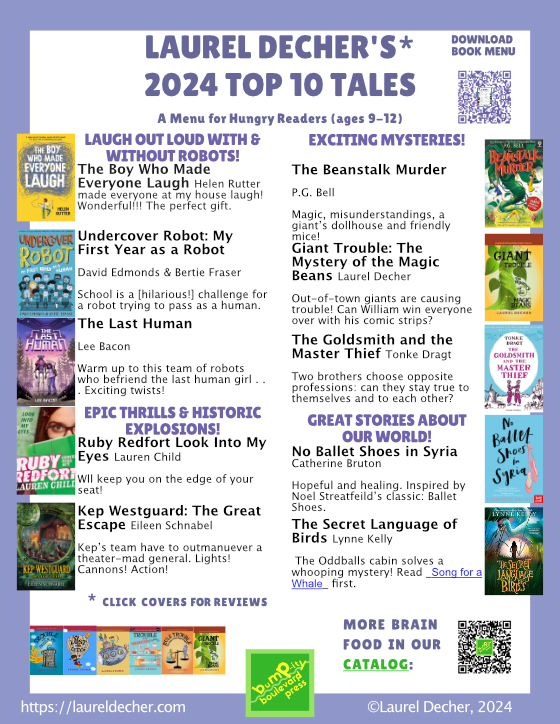Infographic for Motivation Reaction Units.
The best order for character reactions is feeling/thought, action (involuntary or voluntary), speech. You don’t have to include all the reactions every time, but they should be in this order. The reader will be able to take in the story with the least amount of friction.
Do you know the terrible feeling when THAT topic resurfaces?
“Oh no. I AM going to have to learn this.” Prehistoric time periods must have come around 3 or 4 times in my studies, but I still haven’t learned them.
Years and years ago, I read about Dwight W. Swain’s Motivation Reaction Units (MRU’s). *Cough.* It’s filed right behind the prehistoric time periods. It popped up again recently and I wondered if it could help me weave a more seamless story and create more life-like character reactions.
In case you’re in the same fix, here’s a quick summary: MRU’s are a way to show cause and effect in the story, moment to moment. It’s all about the order.
The catch to MRUs is that they must be presented in
the correct order. When you tell readers about the effect before they’ve seen the cause, you’re introducing an element of unreality, however miniscule. Even if their confusion lasts only a microsecond, you’re endangering their ability to process your story in a logical and linear fashion. –K. M. Weiland in STRUCTURING YOUR NOVEL: ESSENTIAL KEYS FOR WRITING AN OUTSTANDING STORY (Chapter 24 Scene Structure)
People who write well about writing inspire me, but I need the “real-life” application. I want to know how middle grade authors get it on the page.
I decided to test MRU’s with an author I admire. Here’s a passage from Chapter 2 of Sara Prineas’ LOST, the wonderful second book in THE MAGIC THIEF series.
What patterns do you see?
(Feel free to color-code the passage for yourself. My color-coded version follows.)
I blinked the brights out of my eyes. The floor of my workroom was covered with shattered glass and torn book pages. The table lay with its four legs in the air like a dead bug. Smoke and dust swirled around in the corners. A scrap of charred paper floated to the floor next to me. I squinted at it. A page from Prattshaw’s book, the part about contrafusive effects.
The pyrotechnics had worked. The magic had spoken to me again—without a locus stone. But what had it said?
Step step tap. I heard the sound of Nevery hurrying up the stairs. He threw open the door. “Curse it, boy!” he shouted. “What are you up to?”
I coughed, brushed slivers of glass out of my hair, and got to my feet. “Just some pyrotechnics,” I said. I looked down at my apprentice’s robe. It had a few more scorch marks on it than before.
Nevery scowled. “A pyrotechnic experiment. I thought you had more sense.” He lowered his bushy eyebrows. “And where did you come up with the slowsilver, hmmm?”
I shrugged.
More footsteps, and Benet, Nevery’s bodyguard-housekeeper, loomed up behind Nevery in the doorway. His knitted red waistcoat and shirt were dusted with flour, and he had a smudge of flour on his fist-flattened nose; he’d been kneading dough. “He all right?” he asked.
“Yes, I am,” I said. “Nevery, the magic spoke to me.”
Nevery opened his mouth to shout at me some more, and then closed it.
“Spoke to you? A pyrotechnic effect, then. You were right. Interesting. What did it say?”
“It sounded—” I shook my head. Had the magic sounded frightened? But of what? “D’you know this spell?” I recited the spellwords the magic had said to me: “Damrodellodesseldeshellarhionvarliardenliesh.”
Here's my color-coded version of the same passage:
- Red = stimulus.
- Gray-blue = reaction.
- The MRU theory says the gray-blues should go from light to dark.
I blinked the brights out of my eyes. The floor of my workroom was covered with shattered glass and torn book pages. The table lay with its four legs in the air like a dead bug. Smoke and dust swirled around in the corners. A scrap of charred paper floated to the floor next to me. I squinted at it. A page from Prattshaw’s book, the part about contrafusive effects.
The pyrotechnics had worked. The magic had spoken to me again—without a locus stone. But what had it said?
Sara Prineas still has me on board, but this is the opposite of the MRU theory. I got STIMULUS–REACTION(2. action)–REACTION(1. thought). What did you get?
Step step tap. I heard the sound of Nevery hurrying up the stairs. He threw open the door. “Curse it, boy!” he shouted. “What are you up to?”
I coughed, brushed slivers of glass out of my hair, and got to my feet. “Just some pyrotechnics,” I said. I looked down at my apprentice’s robe. It had a few more scorch marks on it than before.
The reactions alternate between action and speech and action and thought. This feels totally natural to me.
STIMULUS–REACTION(2. action)–REACTION(3. speech)–REACTION(2. action)–REACTION(1. thought)
Nevery scowled. “A pyrotechnic experiment. I thought you had more sense.” He lowered his bushy eyebrows. “And where did you come up with the slowsilver, hmmm?”
I shrugged.
This simpler example fits the MRU theory even though some types of reactions are missing.
STIMULUS–REACTION(2. action)
More footsteps, and Benet, Nevery’s bodyguard-housekeeper, loomed up behind Nevery in the doorway. His knitted red waistcoat and shirt were dusted with flour, and he had a smudge of flour on his fist-flattened nose; he’d been kneading dough. “He all right?” he asked.
“Yes, I am,” I said. “Nevery, the magic spoke to me.”
Nevery opened his mouth to shout at me some more, and then closed it.
These all follow the MRU theory with one type of reaction in each set.
STIMULUS–REACTION(1. thought)
STIMULUS–REACTION(3. speech)
STIMULUS–REACTION(1. thought)
“Spoke to you? A pyrotechnic effect, then. You were right. Interesting. What did it say?”
“It sounded—” I shook my head. Had the magic sounded frightened? But of what? “D’you know this spell?” I recited the spellwords the magic had said to me: “Damrodellodesseldeshellarhionvarliardenliesh.”
This set reverses the MRU theory (3,2,1) and then circles back around to speech. The internal question “But of what?” could also be a STIMULUS followed by a REACTION(3. speech).
STIMULUS–REACTION(3. speech)–REACTION(2. action)–REACTION(1. thought)–REACTION(3. speech)
Don't you love that feeling that something was worth learning after all?
Sara Prineas’s well-crafted prose makes me see how much variety is possible. After studying this passage, I’m eager to look at my own work for stimulus–reaction patterns. The sheer number of stimulus-reactions gives the story a feeling of connectedness.
What have you noticed about character reactions in your reading or writing?
Do you have favorite authors who follow or don’t follow the MRU patterns? I’d love to read more examples.
It’s not easy to find books for ages 9 to 12. Time can be limited when you’re in a bookstore or library and you need ideas fast.
The books aren’t a short read for parents, teachers or librarians.
That’s why I share my favorite books for this age group in my Readers List and with free downloadable PDFs.



